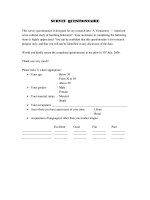(Luận văn thạc sĩ) a vietnamese american cross cultural study of encouraging
Bạn đang xem bản rút gọn của tài liệu. Xem và tải ngay bản đầy đủ của tài liệu tại đây (135.56 KB, 5 trang )
VIETNAM NATIONAL UNIVERSITY, HANOI
UNIVERSITY OF LANGUAGES AND INTERNATIONAL STUDIES
FACULTY OF POSTGRADUATE STUDIES
LẠI THỊ THANH VÂN
A VIETNAMESE – AMERICAN
CROSS-CULTURAL STUDY OF ENCOURAGING
NGHIÊN CỨU GIAO VĂN HÓA VIỆT – MỸ
VỀ HÀNH ĐỘNG KHÍCH LỆ
MA COMBINED PROGRAMME THESIS
Field: English Linguistics
Code: 60.22.15
HANOI – 2010
VIETNAM NATIONAL UNIVERSITY, HANOI
UNIVERSITY OF LANGUAGES AND INTERNATIONAL STUDIES
FACULTY OF POSTGRADUATE STUDIES
LẠI THỊ THANH VÂN
A VIETNAMESE – AMERICAN
CROSS-CULTURAL STUDY OF ENCOURAGING
NGHIÊN CỨU GIAO VĂN HÓA VIỆT – MỸ
VỀ HÀNH ĐỘNG KHÍCH LỆ
MA COMBINED PROGRAMME THESIS
Field: English Linguistics
Code: 60.22.15
Supervisor: Prof. Nguyễn Quang, Ph.D.
HANOI – 2010
iv
TABLE OF CONTENTS
CERTIFICATE OF ORIGINALITY OF PROJECT REPORT ........................................ i
ACKNOWLEDGEMENTS ............................................................................................. ii
ABSTRACT .................................................................................................................... iii
TABLE OF CONTENTS ................................................................................................ iv
LIST OF ABBREVIATIONS AND CONVENTIONS .................................................... vii
LIST OF TABLES .......................................................................................................... viii
LIST OF FIGURES ......................................................................................................... ix
INTRODUCTION ......................................................................................................... 1
1. Rationale .............................................................................................................. 1
2. Aims of the study ................................................................................................. 1
3. Scope of the study ................................................................................................ 2
4. Methods of the study............................................................................................ 2
5. Organisation of the study .................................................................................... 3
DEVELOPMENT.......................................................................................................... 4
Chapter 1: LITERATURE REVIEW ............................................................................. 4
1.1. Pragmatics and cross-cultural pragmatics ............................................................ 4
1.2. Speech acts ......................................................................................................... 5
1.2.1. Definition of speech acts .......................................................................... 5
1.2.2. Classifications of speech acts ................................................................... 7
1.2.3. Encouraging as a speech act ..................................................................... 9
1.2.4. Encouraging and comforting .................................................................... 10
v
1.3. Politeness in Cross-cultural pragmatics ............................................................... 10
1.3.1. Politeness defined..................................................................................... 10
1.3.2. Conversational-maxim view on politeness ................................................ 12
1.3.3. Face-management view on politeness ....................................................... 13
1.3.4. Social variables affecting politeness ......................................................... 18
Chapter 2: METHODOLOGY ....................................................................................... 20
2.1. Research questions .............................................................................................. 20
2.2. Research design .................................................................................................. 20
2.2.1. Data collection instruments ...................................................................... 20
2.2.2. Variables manipulated in data collection instruments................................ 21
2.2.3. Contents of the questionnaires .................................................................. 22
2.2.4. Informants ................................................................................................ 24
2.2.5. Data collection procedure ......................................................................... 24
2.3. Results of the MPQ ............................................................................................. 25
2.4. Realisation of politeness strategies in encouraging .............................................. 29
Chapter 3: FINDINGS AND DISCUSSION .................................................................. 38
3.1. Overall number of strategies ............................................................................... 38
3.2. Overall use of strategies ...................................................................................... 42
3.3. Use of strategies by social variables .................................................................... 44
3.4. Use of strategies by situations ............................................................................. 48
3.4.1. Choice of encouraging strategies in high-power settings (+P) ................... 50
3.4.2. Choice of encouraging strategies in equal-power settings (=P) ................. 54
3.4.3. Choice of encouraging strategies in low-power settings (–P) .................... 59
vi
CONCLUSION .............................................................................................................. 65
1. Review of the main findings ................................................................................ 65
2. Implications.......................................................................................................... 68
3. Limitations ........................................................................................................... 68
4. Suggestions for further study .............................................................................. 69
REFERENCES................................................................................................................ 71
APPENDICES ................................................................................................................ I
Appendix A: Metapragmatic Questionnaires (MPQ) .................................................. I
Appendix B: Discourse Completion Task (DCT) ....................................................... XVII
Appendix C: Frequency Analysis for VNS and ANS ................................................. XXI
Appendix D: Independent-Sampes t-Test Analysis for VNS and ANS ....................... XXV









